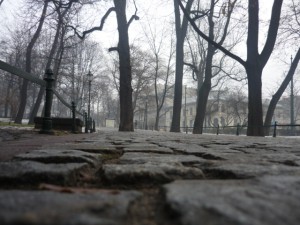Dec. 24 – Krakow, Poland
What is it about cobblestones? Do they interest me just because I’m North American and don’t  encounter them at home? Is it that I only ever see them in movies, picture books, paintings? Possibly. But there is more to it than that.
encounter them at home? Is it that I only ever see them in movies, picture books, paintings? Possibly. But there is more to it than that.
I had been wondering what about Krakow made it so intensely compelling, and I finally figured out that the answer was literally at my feet. Cobblestones aren’t alive, but there is life to them. Cobblestone streets were made by people, not machines. You think of labourers gripping heavy hammers and chisels, quarrying rock and roughly shaping it. It is easy to imagine their aching backs as they hunched to place the stones in mortar on the ground. Similar to people, cobblestones all differ. Some are bigger, some are rounder, some are smoother, some cracked and crumbling. No step you take on cobbles will be the same as the previous one, as your soles and ankles adjust to the uneven surface. And like people, when you bring many cobblestones together you can create something important. You can get somewhere.
In Krakow, the rough textures are not only at your feet. Walls, buildings, towers are all made of brick and stone. Some have new plaster. Others, particularly in the old Jewish quarter of Kazimierz, are benignly neglected, picturesquely cracked, paint faded. The old town is sheltered from the vicious, snarling traffic I encountered in China, Russia, even Ukraine. What struck me about the broad Glowny Rynek (main market square) is that it remains a place for people where cars rarely intrude. The sounds are all human – the general hum of a crowd, the distinct clarity of a mother calling to her child, footsteps. Black-cassocked clergymen doff their hats to one another. Nuns stride in pairs. At noon yesterday, a long line of people waited patiently for their free Christmas tree – a radio station marketing promotion. Last night, from a balcony overlooking the square, musicians took turns playing. A folk singer, a guitarist, a gently improvising trombonist. There were Christmas lights, and booths selling crafts, sausages, pierogies, mulled wine. It is festive but low-key.
brick and stone. Some have new plaster. Others, particularly in the old Jewish quarter of Kazimierz, are benignly neglected, picturesquely cracked, paint faded. The old town is sheltered from the vicious, snarling traffic I encountered in China, Russia, even Ukraine. What struck me about the broad Glowny Rynek (main market square) is that it remains a place for people where cars rarely intrude. The sounds are all human – the general hum of a crowd, the distinct clarity of a mother calling to her child, footsteps. Black-cassocked clergymen doff their hats to one another. Nuns stride in pairs. At noon yesterday, a long line of people waited patiently for their free Christmas tree – a radio station marketing promotion. Last night, from a balcony overlooking the square, musicians took turns playing. A folk singer, a guitarist, a gently improvising trombonist. There were Christmas lights, and booths selling crafts, sausages, pierogies, mulled wine. It is festive but low-key.
Which is not to say that Krakow is stuck in the past. The cobbles are more timeless than time-bound. The market square was always a place for wealthy vendors to trade, and today those vendors have names like Gap, Prada, Bulgari. Steel rails cut through for sleek new trams to pass, whispering loudly. Streetcars have rolled on Krakow’s streets since 1882. And I’ve seen many iPod-wearing joggers taking advantage of their Christmas break to run along the placid, swan-studded Wisla.
I’m going back out to see how Christmas gets celebrated here and will report back tomorrow. To all, a good night!

2 Responses to A walk around Krakow